Facts About Thomas Edison
Written by Aindrila Jana, a contributory writer
Do you know – what about the light bulb did Edison invent?
Written by Aindrila Jana, a contributory writer
Thomas Edison (full name Thomas Alva Edison), was one of the most well-known and successful innovators in American history. He was an inventor and a businessman.
Some of his most successful innovations include the phonograph and the incandescent lamp with filament (which finally paved the way for the commercial production of the light bulb). However, while Edison is best known for these inventions, his inventions or refinements of existing technologies went much beyond the two.
Edison’s inventions were also in fields like telegraphy and telephony, sound recording, motion pictures, storage batteries, and mining and cement technology.
In his 84 years, he owned 1,093 patents – many of his inventions had a significant impact on the industrialized world and on our lives today.
Edison’s best-known inventions are the phonograph and the light bulb filament – both of which he invented in the famous laboratory in an area called Menlo Park. It was at this time that Edison earned the moniker, “Wizard of Menlo Park” – as his inventions changed the way people lived (more in detail on this below).
Before we get into detail about his life and his inventions, here’s a look at some of his main inventions.
| Notable Inventions | Year |
|---|---|
| The Phonograph | 1877 |
| Long-lasting filament for the light bulb | 1879 |
| The world’s first economically viable electric power distribution system | 1882 |
| Kinetoscope (motion picture) | 1888 |
| Electric Vote Recorder | 1869 |
| Loud Speaking Telephone | 1877 |
About Thomas Alva Edison
Thomas Alva Edison was born on February 11, 1847, in Milan, Ohio, USA.
Born in Ohio, Thomas Edison grew up in Port Huron, Michigan as his family moved there in 1854. His parents were Canadian – his father’s name was Samuel Ogden Edison Jr., and his mother was Nancy Matthews Elliott, an accomplished school teacher.
Thomas Edison was the seventh and the last child.
The early learning years
Did you know – Thomas Edison was homeschooled?
Initially, Thomas was sent to school, but he was often punished by the teachers for annoying them with too many questions. He didn’t do very well in the traditional school setting.
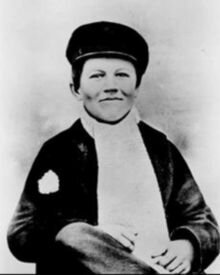
Image Credit: menloparkmuseum.org
He attended a formal school only for a few months and eventually got homeschooled by his mother, and he learned most things by reading on his own. His interest in science started when he received his first scientific book, The School of Natural Philosophy from his mother. Edison’s mother taught him reading, writing, and arithmetic.
He was fascinated with technology from a very early age and would spend hours working on experiments at home, many of which failed. often leading to explosions. His parents asked him to move his laboratory to the basement after a few disasters. However, even then the explosions from the basement would shake the house constantly and upset his father.
He was hard of hearing
At the age of 12, Edison developed hearing problems. He got Scarlet Fever (common at the time), during childhood and recurring untreated middle-ear infections probably led to partial deafness. He became completely deaf in one ear and had a minimal hearing in the other ear. But, such was his will to work on inventions that Edison believed that his hearing loss helped him to avoid distractions and allowed him to concentrate more on his work.
Worked early to fund his experiments
Edison was a keen innovator and liked to spend time experimenting with technology.
But, he needed money for these and so he took up jobs here and there. He took a job as a newsboy on the new Grand Trunk Railway service, where he sold candy and some other refreshments.
Experiments and disasters….
Never on to waste time, Edison even conducted his experiment while working there – he set up a laboratory in the baggage car of the train. But, here’s what happened. He accidentally started a fire An accidental fire on the train during one of his experiments, and that was the end of that! He was fired!
Moving on…
When he was 16, Edison became a telegraph operator at a telegraph office, as he was interested in this technology. But, this too was short-lived as he, once again, blew up the office with one of his experiments.
Started travelling..
Edison spent five years travelling around America working as a telegraph operator in different parts. But, the question to ask is – how did he do these jobs being moderately deaf?
The answer is that this very fact made it easier for him – because the sharp clicking sound of the telegraph machine seemed clearer to him than other the other surrounding sounds.
However, in December of 1868, he decided to quit working and devote time to his inventions.
Inventions, failures, and patents
In 1869, Edison patented the Electrical Vote Recorder. However, it was never used – was said to be too slow in recording the votes.

Edison also invented the stock-ticker machine that received the latest stock price and displayed this at many locations. This too did not seem to excite the investors who he hoped to raise money from.
Then came the breaks…
Edison moved to New York, quite broke. But, this is where he achieved success.
After working in New York for a while, Edison set up an engineering business. He was soon hired by Western Union (the telegraph company) to take care of their equipment.
And here is when the big break came…
Edison was so good at his job that his boss made him an offer to buy out all his new inventions. He gave him $40,000!
Edison used this money to set up a workshop, where he worked on his new inventions. And, while he worked, the workshop also produced stock tickers and telegraphic equipment.
Edison was also commissioned to improve Alexander Graham Bell’s first version of the telephone by Western Union.
A quick word on Edison’s personal life
Edison met 16-year-old Mary Stilwell when she was working at one of his companies, called the News Reporting Telegraph Company. He met her first when she was punching holes in a telegraph tape.
In 1871, when Edison was 24, he married Mary. And such was his dedication to his work that even on his wedding day, Edison went back to work at his laboratory.
The couple had three children – Marion Estelle Edison, Thomas Alva Edison Jr, and William Leslie Edison (fact to know – none of their three children ever had children).
Fun Fact about Thomas Edison: His kids had telegraph-inspired nicknames (since Edison started out in the telegraph industry). Based on the Morse Code system, he nick-named his two eldest children—Marion Edison and Thomas Edison, Jr.—Dot and Dash.
Edison’s Years at Menlo Park
In 1875, Edison set up a laboratory (and also his home) in an area called Menlo Park in New Jersey (a little away from New York).
This was his first major laboratory. Menlo Park was the name of an undeveloped housing project. Edison bought about 34 acres here – most of which was empty farmland.
This is where most of Edison’s inventions came out of
It was at Menlo Park that Edison developed new technologies, primarily in electromagnetics and sound. While he invented many things here (list below), the two he is best known for are the phonograph and a filament for light bulbs.
The Phonograph
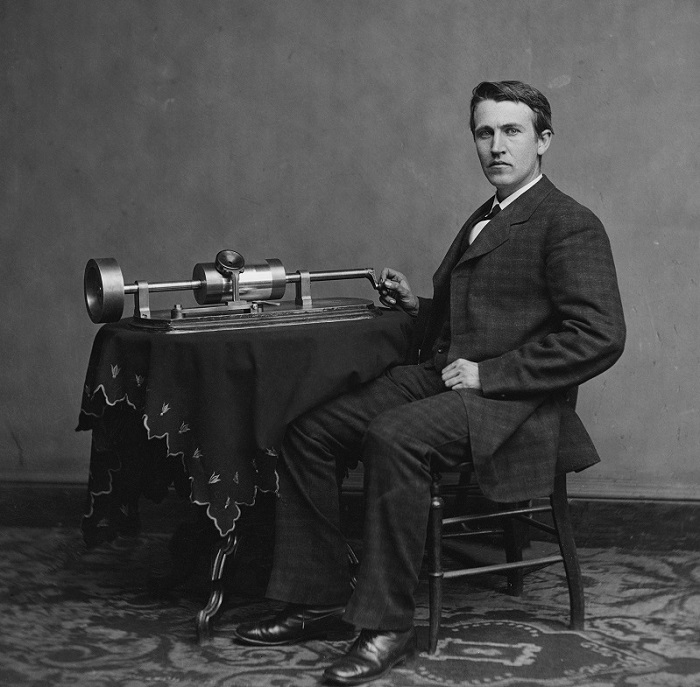
Developed in November 1877, the phonograph was one of Edison’s first major inventions at Menlo Park.
It was a simple machine that recorded someone’s voice as they spoke. The first words Edison recorded on the phonograph were “Mary had a Little Lamb”.
The Wizard of Menlo Park
With the invention of the phonograph, Edison’s fame started to spread far and wide, earning him the title of “The Wizard of Menlo Park.”
People from the world over started to show interest in him and his inventions and many visitors would come to Menlo Park to see the phonograph.
The filament for the light bulb
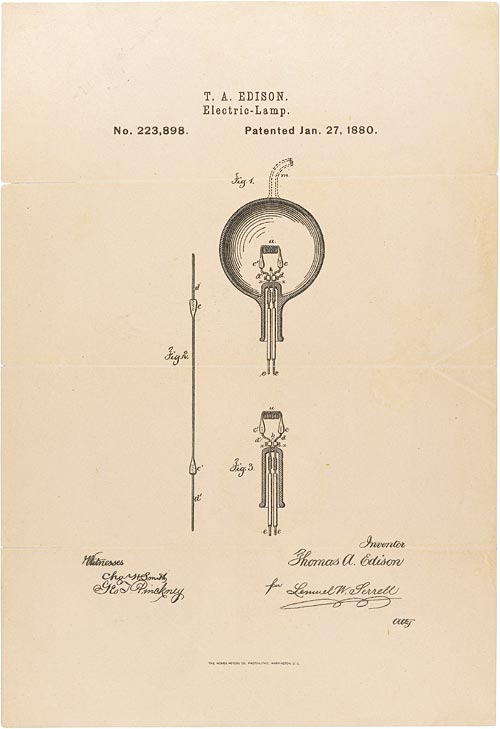
The next big invention that Edison developed was the bamboo filament for the incandescent lightbulb.
The light bulb, per se, was NOT invented by Edison, contrary to popular opinion. What Edison invented was a new kind of filament (the thread-like thing inside the bulb that makes it glow) that would burn for long hours.
In the earlier bulbs, these filaments would not work for more than a few minutes. In November 1879, Edison’s filament first burned for over 13 hours. The ones that followed kept getting better – with the next ones lasting for 40 hours.
By 1880, Edison’s bulbs were selling in large quantities.
Menlo Park was lit up. Edison put up many lampposts in Menlo Park. Also, during the 1879 – 1880 New Year’s Eve, a street called Christie Street became the world’s first street to be lit by incandescent light bulbs. This was done with a power system designed by Edison. Moreover, he was also successful in testing the first underground electrical system in November 1880.
What else did Edison develop at Menlo Park?
Here’s a list…
- The dynamic microphone mouthpiece for telephones
- Wire and voice transmission technologies
- The first constant voltage generators
- Many devices for distributing electricity – like underground wires, boxes, switches, fuses, etc
Companies, innovations, and successes
Building on this success, in 1878, Edison established the Edison Electric Light Company. He now began working on electricity that could be used for many other purposes.
Edison founded the Edison Electric Light Company in 1878, mainly to sell his incandescent bulb and later other products. This later turned into General Electric (in 1892), one of the biggest companies in the world.
Here’s a quick list of some of his achievements and experiments
1. An experimental train running on electricity
2. Generating electricity in New York.
On 4th September 1882, history was made. Edison lit up a street in News called Pearl Street. Here’s what happened.
At 3 p.m., on the 4th of September Edison showed the world how electricity could change people’s lives. He fitted about 400 of his bulbs in office buildings and homes in Pearl Street and turned on a generator at the Pearl Street station – and the entire street was lit up.

(Image courtesy of the Consolidated Edison Company of New York.)
This was a big success where hundreds of people came to watch this “magic”!
This was a turning point in Edison’s life. He became rich and famous.
People started to come to Menlo Park to see Edison’s inventions. Many investors also came to meet Edison.
It was during his years at Menlo Park that Edison created some of his greatest inventions. In all, while he was here, he applied for some 400 patents.
Moving on from Menlo Park
Great as his years at Menlo Park were, Edison now wanted to move to the next stage of his career and success.
He felt it would be better to move closer to New York – where his business was. Also, he was growing fast and the facilities at Menlo Park were proving to be inadequate.
Edison and his family moved to New York City. Then, on August 9, 1884, Edison’s wife, Mary, died (it is said she dies of typhoid fever, but some believe it could have been a morphine overdose – morphine is a drug ). This was a devastating event for Edison, who loved Mary dearly.
However, in 1886, he married Mina Miller (they had three children – Madeleine Edison, Charles Edison, and Theodore Miller Edison.).
In 1887, Edison moved his laboratory out of Menlo Park and into a new and bigger one in an area called, West Orange, in the state of New Jersey (near New York). Here he spent the rest 44 four years of his life. He continued to innovate and improve his inventions.
Edison died on October 18, 1931, at the age of 84.
Top 10 Fun Facts About Thomas Edison In 2022
1. Thomas Edison built a chemistry lab on a train in his youth. Edison sold candies and newspapers on the Grand Trunk Railroad. He set up a chemistry lab in the baggage car during that time and also built a printing press for the original newspaper he himself created, named The Grand Trunk Herald.
2. Thomas Edison was not the inventor of the light bulb. In 1840, a British inventor named Warren De La Rue created one of the earliest light bulbs. But the early bulbs were not commercially viable due to their short lifespans and brightness levels. A patent was granted to Edison on January 27, 1880, for developing a cheap and long-lasting incandescent bulb that didn’t require much electricity to function.
3. Thomas Edison was the person behind making creepy talking dolls! He began developing talking dolls and inserted tiny phonographs inside their bodies which played nursery rhymes and songs. But since people couldn’t understand what the playthings were saying and they were expensive too, Edison sold just 500 dolls overall.
4. In the 1920s, Edison created a rigorous job interview test. The applicants had to answer dozens of questions about a wide range of topics from Italian operas to astronomy. Considering the inputs of a job candidate, The New York Times stated that “only a walking encyclopedia” could pass the test.
5. The Henry Ford Museum in Dearborn, Michigan contains a test tube that is said to hold Edison’s last breath. No one can say for sure, but it is said that when Edison died, one of his sons trapped and sealed Edison’s terminal breath in a test tube and sent it to Ford.
6. Nikola Tesla, a Serbian-American engineer, worked for Thomas Edison for a short while. Edison’s devices were reliant on Direct Current or DC and he believed that Alternating Current or AC was unsafe. Tesla saw the potential in AC, unlike Edison. Later, after he parted ways with Edison, Tesla sold patents that relied on alternating current (AC) to industrialist George Westinghouse.
7. Edison had contempt for traditional religious beliefs. He was not an atheist though. Edison was a free thinker and a skeptic. Thomas Paine’s book “The Age of Reason” heavily influenced his religious beliefs.
8. Some of the first motion pictures in history were produced by Thomas Edison. The earliest known cat video to exist was produced by Edison in July 1894. The video shows two cats boxing with gloves on in a boxing ring. It was filmed by Henry Welton and William Heise at Edison’s production studio.
9. Edison suffered from poor health toward the end of his life. He repeatedly went in and out of a coma which eventually led to his death. t is said that a few hours before his death, he woke up briefly and uttered his final words – “It is very beautiful over there.”
10. Edison created a nickel-alkaline battery in 1901 as he thought it would be better than the current batteries in the market. He aimed to use the battery for electric vehicles. Thomas Edison also had a small factory for the production of electric cars. But it was unfortunate for Edison that the manufacturers stopped producing electric vehicles a few years after he created the battery.
A look at some more of Thomas Edison’s inventions
Automatic Telegraphy
Automatic telegraphs were used to transmit messages at higher speeds than those transmitted by Morse telegraph operators. Edison worked on automatic telegraphs between 1870 and 1874.
He developed an improved perforator with a keyboard. The punched tape produced holes that corresponded to dots or dashes of the Morse code. The dashes were larger and they produced a longer signal. The perforated tape was then run through a high-speed transmitter at speeds as high as 1,000 words per minute.
As the perforations passed rapidly under a metal stylus, it would make electrical contact with a revolving drum, which led to the closing of the circuit. This led to a series of rapid, intermittent signals being transmitted to an automatic receiver at the other end of the line.
The automatic telegraph system devised by Edison was used for two years on the lines of the Automatic Telegraph Company and then further for another two years on the lines of the Atlantic and Pacific Telegraph Company as that company gained control of the Automatic Telegraph. Edison also devised a printer for message preparation that could be alluded to as an early form of a typewriter.
Loud-Speaking Telephone
Alexander Graham Bell created the first practical telephone. However, Thomas Edison developed a new kind of telephone to compete with Bell’s.
Edison built on Bell’s concept, but he developed a better transmitter than Bell’s. It basically made it possible for sounds and voices to be transmitted at higher volumes and also more clearly.
It was based on his discovery of the electromyograph principle, which stated that a change in friction was caused by electrochemical decomposition. Applying this principle, he made the sounding diaphragm vibrate by changing the friction between a metallic contact arm and a chemically treated moving surface.
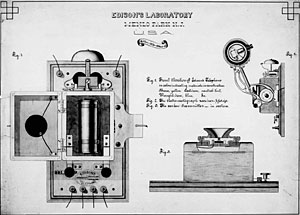
“Image Credit: edison.rutgers.edu
Edison named this discovery, made in 1877, a musical telephone. His logic was that it was loud enough to broadcast music throughout a large auditorium.
These were sent to Britain to be sold and were named, “The Edison Loud-Speaking Telephone.” But, soon after, when the Bell and Edison telephone interests were merged in Britain, the Bell receiver was more popular because it was cheaper and was also much easier to use.
Kinetoscope (motion pictures)
After the success of the phonograph, Edison wanted to design “an instrument that does for the eye what the phonograph does for the ear.”
In 1891 Edison and his assistant, William K. L. Dickson created what was called the Kinetoscope – which was a forerunner of the motion-picture film projector.
What it was and how it worked…

The peephole is on the top
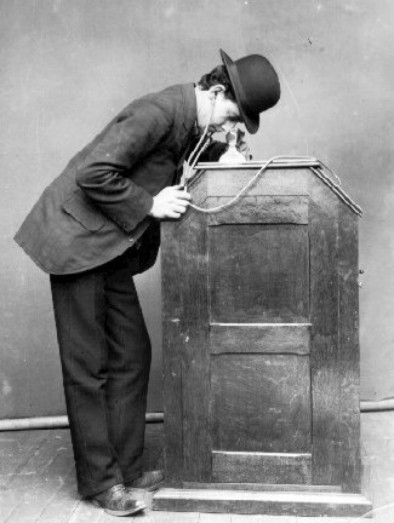
The kinetoscope was a device to view moving pictures without sound. This is why it’s been called the forerunner (that which comes before) to the motion picture camera.
It was a simple device in which a strip of film was passed quickly between a lens and an electric light bulb, as the viewer peered through a little peephole, allowing them to view the moving pictures as the strip rolled past. This made the persons and objects in motion seem lifelike.
In 1894, a five-second clip, named Fred Ott’s Sneeze, was recorded and became the first motion picture to be copyrighted in the US. It shows one of Edison’s assistants, Fred Ott, taking a pinch of snuff and sneezing.
Thomas Edison applied for a patent for the Kinescope which he received on August 31, 1897
Good to know: As with most inventions, when multiple people have worked ad contributed to particular inventions – there’s a debate about how much Edison contributed to the invention of the kinetoscope. Many believe that his assistant, William Kennedy Laurie Dickson, played a bigger role in the experimentation and research and that he should be given the main credit for this.
There was a lot more, of course, to Edison’s life and inventions. We’ve only skimmed the surface here. But we hope you get an idea of what a remarkable inventor he was – what we take for granted today, electricity distribution and the light bulb, to name just two, was thanks to Thomas Alva Edison.
You May Also Like
Facts About Elon Musk
Facts About Albert Einstein

Better Your Child’s G.K. In 3 Minutes – Get This Free Newsletter
Get fun facts, simple and easy news, quizzes, and lots of other interesting things to read in your mailbox – for free! It’s what we call GK-on-the-go!
I Kid You Not now has a large readership across India and also parts of the world. If you want to write for us, you can submit your story here. You can also apply to become a news anchor. Apply here



Comments